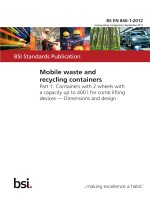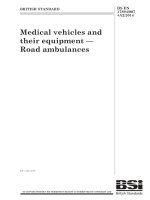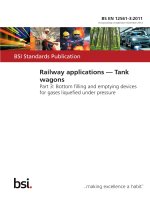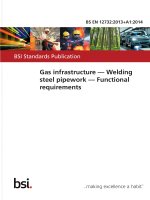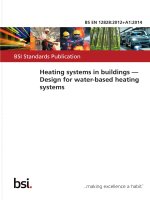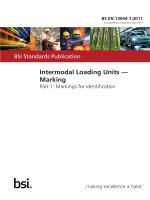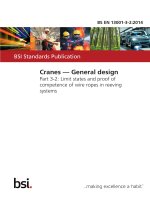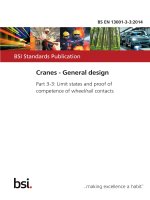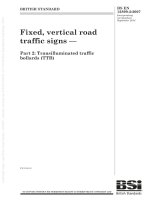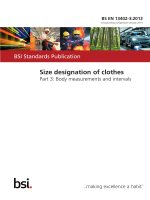Bsi bs en 16602 70 21 2014
Bạn đang xem bản rút gọn của tài liệu. Xem và tải ngay bản đầy đủ của tài liệu tại đây (1.42 MB, 52 trang )
BS EN 16602-70-21:2014
BSI Standards Publication
Space product assurance —
Flammability testing for the
screening of space materials
BS EN 16602-70-21:2014
BRITISH STANDARD
National foreword
This British Standard is the UK implementation of EN
16602-70-21:2014. It supersedes BS EN 14090:2002 which is
withdrawn.
The UK participation in its preparation was entrusted to Technical
Committee ACE/68, Space systems and operations.
A list of organizations represented on this committee can be
obtained on request to its secretary.
This publication does not purport to include all the necessary
provisions of a contract. Users are responsible for its correct
application.
© The British Standards Institution 2014.
Published by BSI Standards Limited 2014
ISBN 978 0 580 84601 4
ICS 13.220.40; 49.025.01; 49.140
Compliance with a British Standard cannot confer immunity from
legal obligations.
This British Standard was published under the authority of the
Standards Policy and Strategy Committee on 30 November 2014.
Amendments issued since publication
Date
Text affected
BS EN 16602-70-21:2014
EN 16602-70-21
EUROPEAN STANDARD
NORME EUROPÉENNE
EUROPÄISCHE NORM
October 2014
ICS 13.220.40; 49.025.01; 49.140
Supersedes EN 14090:2002
English version
Space product assurance - Flammability testing for the
screening of space materials
Assurance produit des projets spatiaux - Essai de
flammabilité pour la sélection des matériaux d'un projet
spatial
Raumfahrtproduktsicherung - Brennverhaltenstest für die
Auswahl von Raumfahrtmaterialien
This European Standard was approved by CEN on 11 April 2014.
CEN and CENELEC members are bound to comply with the CEN/CENELEC Internal Regulations which stipulate the conditions for giving
this European Standard the status of a national standard without any alteration. Up-to-date lists and bibliographical references concerning
such national standards may be obtained on application to the CEN-CENELEC Management Centre or to any CEN and CENELEC
member.
This European Standard exists in three official versions (English, French, German). A version in any other language made by translation
under the responsibility of a CEN and CENELEC member into its own language and notified to the CEN-CENELEC Management Centre
has the same status as the official versions.
CEN and CENELEC members are the national standards bodies and national electrotechnical committees of Austria, Belgium, Bulgaria,
Croatia, Cyprus, Czech Republic, Denmark, Estonia, Finland, Former Yugoslav Republic of Macedonia, France, Germany, Greece,
Hungary, Iceland, Ireland, Italy, Latvia, Lithuania, Luxembourg, Malta, Netherlands, Norway, Poland, Portugal, Romania, Slovakia,
Slovenia, Spain, Sweden, Switzerland, Turkey and United Kingdom.
CEN-CENELEC Management Centre:
Avenue Marnix 17, B-1000 Brussels
© 2014 CEN/CENELEC All rights of exploitation in any form and by any means reserved
worldwide for CEN national Members and for CENELEC
Members.
Ref. No. EN 16602-70-21:2014 E
BS EN 16602-70-21:2014
EN 16602-70-21:2014 (E)
Table of contents
Foreword .................................................................................................................... 4
1 Scope ....................................................................................................................... 5
2 Normative references ............................................................................................. 6
3 Terms, definitions and abbreviated terms............................................................ 7
3.1
Terms from other standards......................................................................................7
3.2
Terms specific to the present standard .....................................................................7
3.3
Abbreviated terms.....................................................................................................7
4 Principles ................................................................................................................ 8
4.1
Test methods ............................................................................................................8
4.2
Screening tests .........................................................................................................8
4.2.1
Overview .....................................................................................................8
4.2.2
Screening Test 1: Upward propagation test ................................................8
4.2.3
Screening Test 2: Standard test method for the determination of the
oxygen concentration limit during the combustion of polymer
materials .....................................................................................................9
4.2.4
Screening Test 3: Electrical wire insulation flammability test method .......... 9
4.3
Configuration test .....................................................................................................9
4.4
Additional tests .........................................................................................................9
5 Requirements........................................................................................................ 10
5.1
5.2
Test procedure .......................................................................................................10
5.1.1
Preparatory conditions .............................................................................. 10
5.1.2
Test methods ............................................................................................11
Quality assurance ...................................................................................................20
5.2.1
Data ..........................................................................................................20
5.2.2
Nonconformance .......................................................................................21
5.2.3
Calibration .................................................................................................21
5.2.4
Traceability ...............................................................................................21
Annex A (normative) Test report – DRD.................................................................. 22
Annex B (informative) Test procedures .................................................................. 25
2
BS EN 16602-70-21:2014
EN 16602-70-21:2014 (E)
Annex C (informative) Preparation and qualification of chemical igniters .......... 30
Annex D (informative) Graphical information ......................................................... 38
Bibliography............................................................................................................. 47
Figures
Figure D-1 Diagram of the equipment used to determine the oxygen concentration limit ...... 38
Figure D-2 Frame used to fix the sample ..............................................................................39
Figure D-3 Sample holder ....................................................................................................40
Figure D-4 Sample holder ....................................................................................................41
Figure D-5 : Samples from thermoplastic polymer materials ................................................. 42
Figure D-6 : Test set up for flammability of electric wires under heated wire conditions
at 25 % by volume oxygen .................................................................................43
Figure D-7 General arrangement of modified burner and flame dimensions ......................... 45
Figure D-8 General arrangement of apparatus for flammability test ...................................... 46
Tables
Table D-1 : Description of test equipment as per Figure D-6 ................................................ 43
3
BS EN 16602-70-21:2014
EN 16602-70-21:2014 (E)
Foreword
This document (EN 16602-70-21:2014) has been prepared by Technical
Committee CEN/CLC/TC 5 “Space”, the secretariat of which is held by DIN.
This standard (EN 16602-70-21:2014) originates from ECSS-Q-ST-70-21C.
This European Standard shall be given the status of a national standard, either
by publication of an identical text or by endorsement, at the latest by April 2015,
and conflicting national standards shall be withdrawn at the latest by April
2015.
Attention is drawn to the possibility that some of the elements of this document
may be the subject of patent rights. CEN [and/or CENELEC] shall not be held
responsible for identifying any or all such patent rights.
This document supersedes EN 14090:2002.
This document has been prepared under a mandate given to CEN by the
European Commission and the European Free Trade Association.
This document has been developed to cover specifically space systems and has
therefore precedence over any EN covering the same scope but with a wider
domain of applicability (e.g. : aerospace).
According to the CEN-CENELEC Internal Regulations, the national standards
organizations of the following countries are bound to implement this European
Standard: Austria, Belgium, Bulgaria, Croatia, Cyprus, Czech Republic,
Denmark, Estonia, Finland, Former Yugoslav Republic of Macedonia, France,
Germany, Greece, Hungary, Iceland, Ireland, Italy, Latvia, Lithuania,
Luxembourg, Malta, Netherlands, Norway, Poland, Portugal, Romania,
Slovakia, Slovenia, Spain, Sweden, Switzerland, Turkey and the United
Kingdom.
4
BS EN 16602-70-21:2014
EN 16602-70-21:2014 (E)
1
Scope
This Standard defines a multitest procedure for the determination of the
flammability characteristics of nonmetallic materials under a set of closely
controlled conditions. The test procedure covers both individual materials and
materials used in configuration. This Standard describes a series of tests to
provide data for aid in the evaluation of the suitability of materials for use in a
space vehicle crew compartment. The data obtained are in respect to the ease of
ignition and the flame propagation characteristics of materials.
All nonmetallic materials are inherently flammable, the degree to which this is
true is dependant on the chemical nature of the material itself and the
environment to which the material is exposed. In the closed environment of a
manned spacecraft this can lead to a potentially dangerous situation and close
control is therefore required.
This standard may be tailored for the specific characteristics and constrains of a
space project in conformance with ECSS-S-ST-00.
5
BS EN 16602-70-21:2014
EN 16602-70-21:2014 (E)
2
Normative references
The following normative documents contain provisions which, through
reference in this text, constitute provisions of this ECSS Standard. For dated
references, subsequent amendments to, or revision of any of these publications
do not apply. However, parties to agreements based on this ECSS Standard are
encouraged to investigate the possibility of applying the more recent editions of
the normative documents indicated below. For undated references, the latest
edition of the publication referred to applies.
EN reference
Reference in text
Title
EN 16601-00-01
ECSS-S-ST-00-01
ECSS system - Glossary of terms
EN 16602-10-09
ECSS-Q-ST-10-09
Space product assurance - Nonconformance control
system
EN 16602-70
ECSS-Q-ST-70
Space product assurance - Materials, mechanical
parts and processes
DIN 50050-1:1986
Testing of materials; burning behaviour of materials;
small burning cabinet
ISO 6941:1984
Textile fabrics - Burning behaviour - Measurement of
flame spread properties of vertically oriented
specimens
6
BS EN 16602-70-21:2014
EN 16602-70-21:2014 (E)
3
Terms, definitions and abbreviated terms
3.1
Terms from other standards
For the purpose of this Standard, the terms and definitions from ECSS-S-ST-00-01
apply, in particular for the following terms:
flammability
For the purpose of this Standard, the terms and definitions from ECSS-Q-ST-70
apply.
3.2
Terms specific to the present standard
3.2.1
oxygen concentration limit during the combustion of
polymeric materials
minimum volumetric amount of oxygen contained in the nitrogenoxygen
mixture, in the presence of which the material can still combust after ignition
from the bottom
NOTE 1
It is expressed as a percentage and determined
using the equation:
n
Clim =
NOTE 2
3.3
∑C
i =1
lim
,i
[3-1]
n
i.e. the arithmetic average of the concentration
limit calculated as a function of the results of
unit measurements of (Clim,i).
Abbreviated terms
For the purpose of this Standard, the abbreviated terms from ECSS-S-ST-00-01
and the following apply:
Abbreviation
Meaning
Clim
minimum volumetric concentration of oxygen contained
in an oxygennitrogen mixture, in the presence of which a
material can still combust after ignition from the bottom.
HMT
hexamethylenetetramine
7
BS EN 16602-70-21:2014
EN 16602-70-21:2014 (E)
4
Principles
4.1
Test methods
Four test methods are included within this Standard. They can be divided into
two different categories:
4.2
•
Screening tests (see clause 4.2), and
•
Configuration tests (see clause 4.3).
Screening tests
4.2.1
Overview
These are the prime tests to be performed on a material to assess its basic
acceptability or otherwise with respect to flammability. They are designed to
test the material under worst case test conditions, with respect to, for instance,
environment, use, or thickness.
The following two tests form the basis for acceptance or otherwise of most nonmetallic materials but are very different in the data generated:
a.
Test 1: Upward propagation test
b.
Test 2: Standard test method for the determination of the oxygen
concentration limit during the combustion of polymer materials
The choice of which test method is used is dependant on the project concerned
and is specified within the business agreement.
Test 3 “Electrical wire insulation flammability test method” is related
specifically to wire insulation materials.
Materials which meet the requirements of these tests can be considered for
general application, within the constraints of the test conditions used.
4.2.2
Screening Test 1: Upward propagation test
The purpose of this test is to determine the flammability characteristics of
candidate materials supplied to a standard format when exposed to an ignition
source applied at the bottom edge. This test in general is applicable to NASA
payloads (e.g. Space Station, STS). See also NASA STD 6001 Test 1.
8
BS EN 16602-70-21:2014
EN 16602-70-21:2014 (E)
4.2.3
Screening Test 2: Standard test method for
the determination of the oxygen
concentration limit during the combustion
of polymer materials
The oxygen concentration limit provides a comparative evaluation of the
tendency of polymeric materials to burn and to assess the fire resistance of these
materials.
The oxygen concentration limit during the combustion of polymer materials is
considered as one of the main indices characterizing the risk of fire which
materials present before being considered for use in environments containing
various oxygen levels.
4.2.4
Screening Test 3: Electrical wire insulation
flammability test method
This test is designed to screen wire insulation for flammability characteristics.
4.3
Configuration test
This test is designed to determine the flammability characteristics of materials
configured in the same manner as that in qualification and subsequent
spacecraft models. It is intended to determine whether a flammability hazard
exists when a material, which fails the basic screening test, is desired to be used.
Materials which are shown to be acceptable in this manner can be accepted for
restricted application, within the constraints of the test conditions used.
Materials which fail this test are subject to a deviation request. Examples are:
4.4
a.
flammable adhesives where the use is to bond two non-flammable
substrates together, or
b.
flammable conformal coatings applied thinly to a non-flammable printed
circuit board.
Additional tests
These tests can be proposed related to the determination of such properties as
flash and fire point, or heat of combustion.
9
BS EN 16602-70-21:2014
EN 16602-70-21:2014 (E)
5
Requirements
5.1
Test procedure
5.1.1
Preparatory conditions
5.1.1.1
Hazards, health and safety precautions
a.
The supplier shall isolate hazardous substances, items and operations
from other activities.
b.
The supplier shall locate items and controls so that personnel are not
exposed to hazards.
NOTE
c.
The supplier shall provide warning and caution notes in operations,
storage, transport, testing, assembly, maintenance and repair
instructions.
d.
The supplier shall place distinctive markings on hazardous items,
equipment or facilities.
NOTE
This marking is for personnel protection.
5.1.1.2
Preparation of samples
5.1.1.2.1
Cleaning
a.
The supplier shall perform on the samples the same cleaning and other
treatment as those performed on the materials to be incorporated into the
spacecraft.
b.
The supplier should not carry out further cleaning or treatment.
5.1.1.2.2
a.
Handling, storage and environmental conditions
The supplier shall avoid contamination of the sample during handling.
NOTE
10
Hazards can be chemical burns, electric shock,
cutting edges, sharp points or toxic
atmospheres.
This can be achieved by the use of, for instance,
suitable protective gloves.
BS EN 16602-70-21:2014
EN 16602-70-21:2014 (E)
b.
In addition, the supplier shall store and handle samples in a
cleanlinesscontrolled area with an ambient temperature of (22 ± 3) °C
and relative humidity of (55 ± 10) %.
NOTE 1
This can be achieved either in a conditioning
room, or by the use of desiccators filled with
silica gel or a saturated salt solution.
NOTE 2
A saturated salt solution of calcium nitrate
gives approximately 51 % humidity at the
testing temperature.
c.
The supplier shall shield coated surfaces from contact by using
polyethylene or polypropylene bags or sheets.
d.
The supplier shall avoid mechanical damage in the standard way by
packing the polyethylene or polypropylenewrapped test pieces in clean,
dust and lintfree material.
e.
The supplier shall label limitedlife material with its relative shelflife and
date of manufacture, or date of delivery if date of manufacture is not
known.
5.1.1.2.3
a.
Identification
For materials submitted for testing, the supplier shall provide a
description of at least the name and nature of the material or processing.
5.1.1.3
Facilities
5.1.1.3.1
Cleanliness
a.
The work area shall be clean and free of dust.
b.
The supplier shall filter the air used for ventilation to prevent
contamination of the workpieces by moisture, oil or dust.
5.1.1.3.2
a.
Special utilities
The supplier shall use oxygen and nitrogen supplies with minimum
purity of 99,9 %.
5.1.2
Test methods
5.1.2.1
Categories
a.
The customer shall specify the choice of the screening test method within
the business agreement.
b.
Materials failing to meet the requirements of the applicable screening test
shall be subject to testing in configuration.
c.
Materials which fail the testing in configuration shall be subject to a
deviation request.
d.
The supplier shall obtain customer approval on a case by case basis
where additional tests are identified.
11
BS EN 16602-70-21:2014
EN 16602-70-21:2014 (E)
5.1.2.2
Screening Test 1: Upward propagation test
5.1.2.2.1
General
a.
The supplier shall follow the test described in clause 5.1.2.5 if the
materials are unavailable in the standard format.
5.1.2.2.2
a.
The specimen shall be free of cuts, abrasions and other flaws as
determined by close visual inspection.
b.
The supplier shall test films, fabrics, sheets and composites in the “as
received” condition with samples in the form of rectangles 300 mm x 64
mm minimum.
c.
The supplier shall test foams and highbulk materials in the “as applied”
thickness with samples in the form of rectangles 300 mm x 64 mm
minimum.
d.
The supplier shall apply primers, coating materials, paints and
pressuresensitive tapes on the substrate materials intended for use, if
known:
e.
The coatings shall be applied in a thickness equivalent to normal use and
postcured in accordance with prescribed manufacturing processes.
f.
If the spacecraft substrate is not available, the coatings shall be applied to
300 mm x 60 mm x 0,075 mm aluminium panels.
g.
The supplier shall condition the test specimens at (22 ± 3) °C and (55 ± 10) %
relative humidity for 24 hours before testing.
5.1.2.2.3
a.
Test conditions: pressures and atmosphere
The test pressure and atmosphere to represent the most hazardous
atmosphere anticipated in the spacecraft shall be specified.
5.1.2.2.4
Test equipment and apparatus - chamber
a.
The test chamber shall have a minimum volume of 250 l.
b.
A window or viewing port for visual observation and recording shall be
included.
c.
Internal lighting shall be installed.
d.
Feedthroughs shall be available for gas inlets, evacuation, venting to air,
and electricity for ignition.
e.
The supplier shall confirm that the outgassing rates of the organic
materials used in the construction of the chamber are acceptable.
5.1.2.2.5
a.
a.
Test equipment and apparatus - pressure gauge
Apparatus shall include a pressure gauge capable of measuring pressures
to an accuracy of 10 hPa.
5.1.2.2.6
12
Preparation of specimen
Test equipment and apparatus – sample holder
Samples shall be supported in a frame which holds them taut.
BS EN 16602-70-21:2014
EN 16602-70-21:2014 (E)
b.
Samples with sufficient rigidity or samples on substrates of sufficient
rigidity and which do not retreat from a heat source by distorting or
violently shrinking may be supported using a simple clamp.
c.
The sample holder should be so constructed as to have a minimum
influence on the test results.
NOTE
5.1.2.2.7
Sample holder can influence the tests results by
conducting heat away from the sample.
Test equipment and apparatus – ignition source
a.
Ignition of the sample shall be accomplished by employing a regulated
energy source.
b.
The ignition source shall consist of a length of AWG 20 gauge Nichrome
wire which has a nominal resistivity of 2,3 Ω/m, sufficient to wind a
minimum of three turns of a solid igniter.
NOTE 1
The nominal diameter of this igniter is 3 mm
with a length of 32 mm. The flame temperature
is (1100 ± 100) °C and burns for a duration of
(25 ± 5) s.
NOTE 2
A suitable source of igniters is available from
NASA White Sands test facility. In addition a
method for the preparation of suitable igniters
is included in Annex C.
c.
The igniter shall be activated by means of a regulated DC power source.
d.
The igniter shall be positioned 6 mm from the lower edge of the sample.
5.1.2.2.8
Propagation rate indicator
a.
The supplier shall observe and record visually the propagation rate
between markers on a scale positioned on the sample holder.
b.
Timing shall be started at the first visual indication of combustion and
stopped when the flame ceases to propagate upwards.
NOTE
5.1.2.2.9
Where appropriate it is acceptable to record the
total burn length either directly or by
subtraction; In this case, overestimation of the
burn length can occur by measuring soot
deposits higher up the sample.
Pretest procedure
a.
Before each series of tests, the supplier should run the pre-test procedure
as described in annex B.1.1 to calibrate the equipment.
b.
If the supplier uses a different procedure, the supplier shall submit it for
customer approval.
5.1.2.2.10 Test procedure
a.
The supplier should run the test procedure as described in annex B.1.2.
13
BS EN 16602-70-21:2014
EN 16602-70-21:2014 (E)
b.
If the supplier uses a different procedure, the supplier shall submit it for
customer approval.
5.1.2.2.11 Acceptance criteria
a.
Materials shall be classified noncombustible, or selfextinguishing if the
combustion zone propagates less than 150 mm into the sample with
minimumuse thickness and the time of burning does not exceed 10
minutes.
b.
There shall be no sparking, sputtering, or dripping of flaming particles
from the test sample.
c.
The supplier shall test a minimum of three samples.
d.
Failure of any of the three constitutes failure of the material.
5.1.2.2.12 Test results
a.
The supplier shall document the test results in conformance with the
DRD in Annex A.
b.
The supplier shall perform a re-test in a larger test chamber if the oxygen
concentration shows a value lower by 20 % of the original test
atmosphere.
5.1.2.3
Screening Test 2: Standard test method for the
determination of the oxygen concentration limit
during the combustion of polymer materials
5.1.2.3.1
General
a.
The supplier shall use this procedure to determine the concentration limit
of oxygen (Clim) during the combustion of candidate materials.
NOTE
b.
The applicability of this test shall be specified in the business agreement.
5.1.2.3.2
a.
Description of the equipment
The suppler shall determine the oxygen concentration limit, during the
combustion of polymer materials.
NOTE
b.
14
This test is based on RKK Energia test method
ZZU.0336.028.
An example of the equipment is shown in
Figure D-1 and Figure D-2.
The flammability testing equipment shall comprise:
1.
a test column mounted vertically made of quartz glass with an
inside diameter of 75 mm and a height of 370 mm;
2.
under the column a quartz tube placed with an inside diameter of
75 mm and a height of 70 mm, filled with a layer of glass balls 3
mm to 5 mm in diameter, which are used to distribute the gaseous
mixture evenly over the section of the tube;
3.
a sample holder clamping the sample from the top in a vertical
position at the centre of the quartz tube;
BS EN 16602-70-21:2014
EN 16602-70-21:2014 (E)
4.
a frame used to grip fabric, foils or film samples;
NOTE
c.
An example of such a frame is given in Figure
D-2.
5.
a gas burner, a tube made of copper with an inside diameter of 2,5
mm, placed along the axis of the quartz column and through the glass
balls layer; being able to maintain the flame temperature at 850 °C;
with a height of the flame of 25 mm; at a pressure of (17 ± 2) kPa;
6.
a spark igniter consisting of two insulated electrodes located on
both sides of the gas burner tube;
7.
an analyser module comprising a mixing chamber and an oxygen
gas analyser installed in the oxygennitrogen mix line, Range: (0 25) % and (0 - 100) %, Accuracy: ± 0,1 %, with a paramagnetic
detector;
8.
a pressure reducing valve, a flowmeter and an onoff valve
installed in the fuel gas line;
9.
a chronometer;
The supplier shall carry out the flammability tests with an exhaust
connected.
5.1.2.3.3
Samples from thermosetting polymer materials not melting
when burning
a.
The materials shall be in the form of a small bar with a section of (4 ± 1)
mm x (10 ± 1) mm and a length of (200 ± 5) mm.
b.
For the tests on woven and film materials, natural and artificial leather
the samples are required in their thickness and shall have the dimension
of (50 ± 1) mm wide and (200 ± 5) mm long.
c.
These samples shall be used fixed in a metal frame.
NOTE
d.
For tests carried out on fibres which do not deform and do not melt when
burnt, samples shall be produced from these fibres in the form of braids
(200 ± 5) mm long and with a linear density equal to (5 ± 0,3) g/m (mass (1
± 0,3) g).
5.1.2.3.4
a.
For example, as depicted in Figure D-4.
Samples from thermoplastic polymer materials which melt
when burning
Samples in the form of a small bar with a section of (4 ± 1) mm x (10 ± 1)
mm and a length of (200 ± 5) mm shall be surrounded with glass fibres
into a lattice work.
NOTE
Such an example is given in Figure D-5.
b.
To produce samples from film materials which melt a sheet one side of which
is equal to 200 mm (length of the sample) with a mass equal to (8 ± 1) g shall be
taken.
c.
The sheet shall be rolled into a compact roll, and shall be surround with
glass fibre to form a bar.
15
BS EN 16602-70-21:2014
EN 16602-70-21:2014 (E)
d.
The mass of the glass fibres shall not exceed 1,6 g (20 % of the mass of the
sample).
5.1.2.3.5
a.
Tests of coatings deposited on metallic surfaces shall be carried out on
samples in configuration simulating a portion of actual equipment.
b.
Tests of coatings deposited on metallic surfaces shall be supported in the
sample holder.
5.1.2.3.6
a.
NOTE 1
An example of sample holder is shown in
Figure D-3.
NOTE 2
Such coatings can be undercoat, paint, enamel
and varnish.
Preparation of the test equipment
The supplier shall prepare the test equipment as follows:
1.
Choose the regulating flow for nitrogen and oxygen so that by
regulating the pressure reducing valves the composition specified
for the gaseous mixture can be obtained.
2.
Check the composition of the gaseous mixture using the gas
analyser.
3.
Enter into the test column a mixture of oxygen and nitrogen as per
that specified, the flow monitored on the flowmeter being equal to
(442 ± 44) cm3/s which enables an average volumetric speed of flow
of the mixture of (10 ± 1) cm/s to be obtained in the tube.
4.
Monitor the level of the oxygen content in the gaseous mixture by
means of the automatic gas analyser.
5.
Light the gas burner and regulate the flow of combustible gas to
0,03-0,05 l/min using the flowmeter.
6.
After having checked that the gas burner is functioning, cut off the
supply of combustible gas to the burner followed by that of the
nitrogenoxygen mix.
5.1.2.3.7
Test procedure
a.
The supplier should run the test procedure as described in annex B.2.1.
b.
If the supplier uses a different procedure, the supplier shall submit it for
customer approval.
5.1.2.3.8
16
Samples for coatings deposited on metallic surfaces
Results
a.
The supplier shall use at least five samples.
b.
The supplier shall document the test results in conformance with the
DRD in Annex A.
BS EN 16602-70-21:2014
EN 16602-70-21:2014 (E)
5.1.2.4
Screening Test 3: Electrical wire insulation
flammability test method
5.1.2.4.1
General
a.
The supplier shall use the electrical wire insulation flammability test only
for gauges AWG 20 to AWG 10 with copper conductors and for normal
pressures with a maximum oxygen concentration of volume fraction 25 %.
5.1.2.4.2
Preparation of specimens
a.
Insulated wire samples shall be free of cuts, abrasions and other flaws as
determined by close visual inspection.
b.
Samples shall be accompanied by full material identification as outlined
in clause 5.1.1.2.3.
c.
The supplier shall cut five specimens, each a metre in length,
consecutively from the same coil of wire.
d.
The supplier shall clean the specimens of foreign matter and residue,
using a method compatible with the insulation being tested.
e.
The supplier shall condition the specimens prior to testing, at (55 ± 10) %
relative humidity and at a temperature of (22 ± 3) °C for a period of at
least 16 hours.
f.
The supplier shall remove approximately 25 mm of the insulation from
both ends of the test specimen.
g.
The supplier shall measure and record the conductor resistance and
ambient temperature.
h.
The supplier shall position the test specimen in the test chamber
following the test procedure set out in clause 5.1.2.4.13.
5.1.2.4.3
Test conditions: pressure and atmosphere
a.
The supplier shall specify the test pressure and atmosphere.
b.
The test pressure and atmosphere shall represent the most hazardous
atmosphere anticipated in the spacecraft within the confines of the scope
of this test.
5.1.2.4.4
Test equipment and apparatus – chamber
a.
The test chamber shall have a volume of at least 250 l.
b.
the test chamber shall conform to DIN 50050-1:1986 with the height
modified according to ISO 6941:1984.
c.
The test chamber shall include:
1.
feedthroughs for the supply of the test atmosphere,
2.
an arrangement for the diffusion of the test atmosphere to
eliminate high flows,
3.
feedthroughs for air,
4.
fuel gas for the burner,
5.
electricity for the sample,
17
BS EN 16602-70-21:2014
EN 16602-70-21:2014 (E)
6.
5.1.2.4.5
an arrangement for mounting the sample under slight tension at
75° to the horizontal.
Test equipment and apparatus – electrical supply
a.
The external electrical supply shall be capable of providing a large steady
DC current up to 100 A.
b.
The external electrical supply shall include voltage and current meters
capable of measuring the voltage drop across the wire and the current
flowing through it to two decimal places.
5.1.2.4.6
a.
A resistance meter capable of measuring resistances under 100 Ω to an
accuracy of 0,01 Ω shall be available.
5.1.2.4.7
a.
Test equipment and apparatus – burner
The burner shall be of a Bunsen or Tirrill type, with a 9,5 mm bore
modified to supply an external supply of air to the burner collar as
outlined in Figure D-7.
5.1.2.4.8
a.
Test equipment and apparatus – resistance meter
Test equipment and apparatus – flame temperature
The flame temperature shall be (1100 ± 100) °C measured at a point 35 mm
from the end of the burner barrel.
NOTE
5.1.2.4.9
a.
This can be achieved with commercial grade
fuel gas (minimum 85 % purity) and forced air
to produce a flame 75 mm high with an inner
blue cone of 25 mm.
Test equipment and apparatus – burner mounting
The burner shall be mounted perpendicular and at 30° to the vertical
plane of the specimen.
NOTE
This is shown in Figure D-8.
5.1.2.4.10 Test equipment and apparatus – wire tension
a.
The specimen shall be kept taut by suspension of a weight as shown in
Figure D-8.
b.
The value of the weight shall be such that no plastic strain is placed on
the wire.
c.
The value of the weight shall be such that it can be adjusted to
accommodate samples of different size and stiffness.
5.1.2.4.11 Test equipment and apparatus – visual record
18
a.
The supplier shall make and retain visual records of all flammability
tests.
b.
The supplier shall position an internal or external timer that it is visible to
the camera during replay.
BS EN 16602-70-21:2014
EN 16602-70-21:2014 (E)
5.1.2.4.12 Pretest procedure
a.
The supplier should run the pre-test procedure as described in annex
B.3.1.
b.
If the supplier uses a different procedure, the supplier shall submit it for
customer approval.
5.1.2.4.13 Test procedure
a.
The supplier should run the test procedure as described in annex B.3.2.
b.
If the supplier uses a different procedure, the supplier shall submit it for
customer approval.
5.1.2.4.14 Acceptance criteria
a.
Prior to flame application there shall be no spontaneous combustion,
splitting of the insulation or baring of the conductor.
b.
During ignition and combustion there shall be no flaming droplets or
particles.
c.
After the burner is extinguished the wire shall cease flaming within ten
seconds and within a total burn length of 150 mm, measured from the
downward extent of propagation to the upward extent of propagation
and including damage caused by the burner itself.
5.1.2.4.15 Test results
a.
The supplier shall document the test results in conformance with the
DRD in Annex A.
5.1.2.5
Test 4: Configuration test method
5.1.2.5.1
Test sample configuration
a.
The sample to be tested shall be fully representative of the configuration
in which the materials proposed are used.
b.
The unit shall contain materials configured and processed in the “as to be
used” state.
c.
Metallic materials shall be representative of the alloy to be used.
d.
For expensive components which are simulated, the basic material,
geometry and mass of the components shall be in the “as to be used”
state.
NOTE
5.1.2.5.2
a.
An example of simulation is the use of failed or
substandard electronic components instead of
usable ones.
Test pressure and atmosphere
The test pressure and atmosphere shall be as defined by the system
requirements.
19
BS EN 16602-70-21:2014
EN 16602-70-21:2014 (E)
5.1.2.5.3
a.
Test equipment and apparatus
Ignition shall be either by electrical overload (simulating worst-case
conditions) or by open flame.
5.1.2.5.4
Pretest procedure
a.
The supplier shall follow the pre-test procedure in conformance with the
requirements in clause 5.1.2.2.9.
b.
Before the test, the supplier shall perform a fire hazard analysis that
defines the critical items per area and the placement of the igniter or the
wiring which may be subject to electrical overload.
c.
In this latter case, the supplier shall define current/voltage levels which
are representative of the anticipated worst case failure conditions.
d.
The supplier shall photograph the sample showing the positioning of the
igniter before and after each test.
5.1.2.5.5
a.
The supplier shall follow the test procedure for the upward propagation
test in conformance with the requirements in clause 5.1.2.2.10 or apply an
electrical current to the defined wiring, such that ignition occurs.
5.1.2.5.6
a.
Test procedure
Acceptance criteria
The results of the test shall demonstrate that there cannot be a
propagation of flame to adjacent materials and no sputtering, dripping or
release of hot or burning particles.
NOTE
5.1.2.5.7
a.
5.2
Test results
The supplier shall document the test results in conformance with the
DRD in Annex A.
Quality assurance
5.2.1
a.
20
Where this can be so demonstrated the material
is acceptable for use in the configuration as
tested.
Data
The supplier shall retain the quality records for at least ten years or in
accordance with business agreement requirements, and contain as a
minimum the following:
1.
copy of final inspection documentation;
2.
nonconformance reports and corrective actions (if applicable);
3.
copy of the inspection and test with reference to the procedure.
BS EN 16602-70-21:2014
EN 16602-70-21:2014 (E)
5.2.2
a.
Nonconformance
The supplier shall process any nonconformance which is observed in
respect of the test in conformance with the quality assurance
requirements, in ECSS-Q-ST-10-09.
5.2.3
Calibration
a.
The supplier shall calibrate any measuring equipment to traceable
reference standards.
b.
The supplier shall record any suspected or actual equipment failure as a
project nonconformance report in conformance with the DRD in Annex A
of ECSS-Q-ST-10-09.
NOTE
c.
The supplier shall notify the customer of the nonconformance details.
5.2.4
a.
This is to ensure that previous results can be
examined to ascertain whether or not
reinspection and retesting is required.
Traceability
The supplier shall maintain traceability throughout each test from
incoming inspection to final test, including details of test equipment and
personnel employed in performing the task.
21
BS EN 16602-70-21:2014
EN 16602-70-21:2014 (E)
Annex A (normative)
Test report – DRD
A.1
DRD identification
A.1.1
Requirement identification and source document
This DRD is called from ECSS-Q-ST-70-21, requirements 5.1.2.2.12a, 5.1.2.3.8b,
5.1.2.4.15a, 5.1.2.5.7a.
A.1.2
Purpose and objective
The purpose of the test report is to summarize the test results.
A.2
Expected response
A.2.1
<1>
Scope and content
Description of sample tested
<1.1> Trader name
a.
The test report shall contain the trader name of the tested sample.
<1.2> Manufacturer
a.
The test report shall contain the name of the manufacturer of the tested
sample.
<1.3> Production date
a.
The test report shall contain the production date of the material, if
known;
<1.4> Chemical nature
a.
The test report shall describe the chemical nature of the tested sample.
<1.5> Dimension
a.
22
The test report shall include the dimension of the tested sample.
BS EN 16602-70-21:2014
EN 16602-70-21:2014 (E)
<1.6> Weight and surface area
a.
The test report shall include the weight and surface area of the nonmetallic materials.
<1.7> Test atmosphere
a.
The test report shall describe the test atmosphere.
<1.8> Maximum temperature
a.
The test report shall contain the maximum specified temperature.
<1.9> Material identification
a.
The test report shall contain the identification by generic name of all
materials tested in the configuration sample.
<1.10>
a.
<2>
a.
<3>
a.
<4>
a.
<5>
a.
<6>
a.
<7>
a.
<8>
a.
Processing details
The test report shall contain processing details.
Burning information
The test report shall contain the time, length, rate of burning, the time of
any afterburn and the flame application time.
Combustion characteristics
The test report shall contain combustion characteristics.
Flame propagation paths
The test report shall contain the flame propagation paths within the
assembly.
Nature of the flame
The test report shall include the observations concerning the nature of the
flame.
Oxygen percentage
The test report shall contain percentage oxygen remaining at the end of
test.
Oxygen concentration
The test report shall contain the oxygen concentration limits for each test
taken separately and their average value.
Date
The test report shall contain the date on which the tests were carried out.
23
